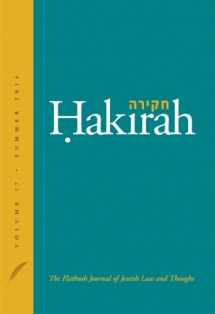
Hakirah: The Flatbush Journal of Jewish Law and Thought
ISBN-13:
9781936803064
ISBN-10:
1936803062
Author:
Sheldon Epstein, Nathan Aviezer, Ari Z. Zivotofsky, Bernard Dickman, Yonah Wilamowsky, Eli Rubin, Zvi Ron, Yaakov Jaffe, Ari Greenspan, Moshe Maimon
Publication date:
2014
Publisher:
Hakirah
Format:
Paperback
296 pages
FREE US shipping
Book details
ISBN-13:
9781936803064
ISBN-10:
1936803062
Author:
Sheldon Epstein, Nathan Aviezer, Ari Z. Zivotofsky, Bernard Dickman, Yonah Wilamowsky, Eli Rubin, Zvi Ron, Yaakov Jaffe, Ari Greenspan, Moshe Maimon
Publication date:
2014
Publisher:
Hakirah
Format:
Paperback
296 pages
Summary
Hakirah: The Flatbush Journal of Jewish Law and Thought (ISBN-13: 9781936803064 and ISBN-10: 1936803062), written by authors
Sheldon Epstein, Nathan Aviezer, Ari Z. Zivotofsky, Bernard Dickman, Yonah Wilamowsky, Eli Rubin, Zvi Ron, Yaakov Jaffe, Ari Greenspan, Moshe Maimon, was published by Hakirah in 2014.
With an overall rating of 3.9 stars, it's a notable title among other
books. You can easily purchase or rent Hakirah: The Flatbush Journal of Jewish Law and Thought (Paperback) from BooksRun,
along with many other new and used
books
and textbooks.
And, if you're looking to sell your copy, our current buyback offer is $0.3.
Description
Challenges to the tenets of Judaism abound in the modern world. Scientific discoveries and theories sometimes seem to negate fundamental principles of the Torah and often call into question the reasoning be-hind individual halakhot. Humanist values and widely accepted ethical norms sometimes clash with Torah thought and the teachings of our Rabbis. This edition of Hakirah focuses on these clashes and the different approaches taken both recently and historically to confront modernity. A recent book by a prominent Rosh Yeshiva who is also an accomplished mathematician takes an extreme position in the “Torah and Science” debate that has been waging within the Torah community for almost ten years. His position is that Hazal were infallible in matters of science and that all Rishonim adhered to this position. A review of this book by an Orthodox physicist takes issue with some of the book’s claims, focusing primarily on the author’s dismissal of the reliability of science. In our Jewish Thought section, a leading Orthodox bio-ethicist seeks to define “Modern Orthodoxy,” by detailing what modernity stands for and by putting forth his own vision for an Orthodoxy that would in-corporate these values within halakhic Judaism. Another article puts forth the idea that the concept of mamlekhet kohanim demands that Judaism always remain distinct from the civilizations around them and their accepted norms and that Torah values are unique and eternal. A special section, Hassidim and Mitnagdim, contains articles dealing with the different approaches taken by these two groups in confronting modernity. The first essay goes back to the period of the haskalah and contrasts the attitude of some in the Mussar movement to haskalah, that “the good in it was to be embraced and the evil it entailed was to be fixed,” with the attitude of Hassidus, which stood for total distancing. The second essay, “On Confrontation with the Secular World,” translates a siha given by the Lubavitcher Rebbe at an event attended by Rav Yosef Dov Soloveitchik, where the author contends the Rebbe was explaining the reasoning behind his own approach in building Judaism in America. Five articles comprise a section called Halakhah and Minhag. Some of these articles explore the fine line between these two concepts. The first article deals with the history of baking matzos and attempts to deter-mine when and why traditionally “soft” matzos were replaced by the commonly used “hard” wafer-like matzos of today. Another article focuses on the layout of Az Yashir in sifrei torah in order to explain why the guidelines Rambam gives for the writing of a sefer torah were abandoned in later years. Other articles question the validity of some minhagim. One such article reviews the book Kaddish, Women’s Voices and evaluates the appropriateness of women saying Kaddish both halakhically and historically. Another article traces a change in the text of Kel Malei Rahamim. A final article, “The Ashkenzic Custom not to Slaughter Geese in Tevet and Shevat,” finds a source in the Shulhan Arukh for an obscure halakhah that has rightly been abandoned. Two articles deal with faith. “The Binding of Isaac” explains how the Akeida demonstrated for all time that “within the recesses of man’s heart resides the exalted ability to conquer the self in favor of the divine,” while, “Squaring the Circle of Faith,” attempts to get to the source of faith utilizing the commonality of thought between Isaiah Berlin and the Baal ha-Tanya The two Hebrew articles mix modern and classical approaches to revisit ancient issues. The old controversies over the size of classical shiurim are revisited in an article that uses the sources of antiquity to suggest a new solution. The second article categorizes the disagreements between the Amoraim Rava and Abbaye based on their philosophical and societal leanings.


We would LOVE it if you could help us and other readers by reviewing the book
Book review

Congratulations! We have received your book review.
{user}
{createdAt}
by {truncated_author}


